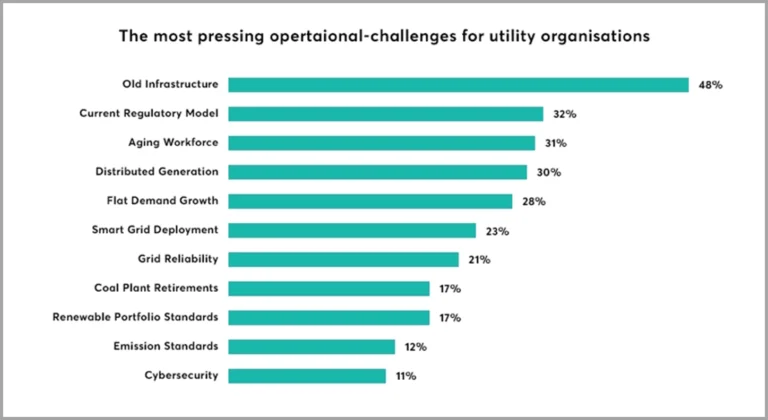With the world’s population expected to reach 9.7 billion by 2050, energy facilities must maximize output to meet the growing demand without overburdening equipment capacity. Moreover, with the increasing energy consumption, the global market size of energy asset management is also estimated to reach $12.4 billion by 2031, increasing at a CAGR of 11.3%, making it imperative for companies in the energy sector to invest in maintaining the health of their green assets.
Asset management in the utility industry is essential as it requires the systematic planning, use, and maintenance of physical assets throughout service, such as turbines, transmission lines, transformers, etc., to ensure longevity. From improved productivity to lower maintenance cost, enhanced equipment reliability, and safety, effective asset management can help companies make the best use of their resources.
In fact, a Mckinsey report states that energy facilities that implement robust asset management strategies to keep their green assets functional, efficient, and cleaner experience an average increase in production efficiency of up to 20%. However, managing assets in a capital-intensive industry like the utility is challenging and complex considering the industry’s uncertainties, such as maintenance and inspection in remote locations, underutilization of products, long asset life, limited knowledge, and environmental factors.
As a result of the industry’s complexity and quick evolution, asset management in the energy sector faces a number of the following challenges:
Power plants, transmission lines, and distribution networks are just a few examples of energy assets that have been in use for many years. Reliability, scalability, and maintenance are some of the concerns associated with aging infrastructure that impacts the performance and efficiency of assets. Therefore, it is the responsibility of Asset managers to work towards increasing the usefulness of these assets, reduce downtime, and schedule timely upgrades or replacements.
On the other hand, with utilities moving to smarter grids, the industry is facing increased demand for more technical skills to perform jobs involving technologies such as AI, big data, and cybersecurity. If reports are to be believed, almost half of the utility workforce, including the most experienced and tenured ones, is about to retire in the next few years. A lack of highly skilled resources has already started causing havoc and impacting the utility industry’s future.
The energy sector is undergoing tremendous technological development, including the incorporation of smart grids, digitalization, and renewable energy sources. Adopting and integrating these technologies into current asset management procedures necessitates large financial outlays, the development of new skills, and organizational changes. The complexity of new technology must be navigated by asset managers while ensuring seamless connectivity with existing systems is achieved.
The energy industry produces enormous amounts of data from a variety of sources, such as sensors, meters, and maintenance logs. Asset managers frequently struggle with issues like poor data quality, data integration across numerous platforms, and a lack of qualified employees for data analytics in the utility industry. Predictive maintenance, asset optimization, and decision-making can all benefit from the efficient management and analysis of this data.
To maintain safety, environmental sustainability, and fair competition, the energy markets are subject to a number of rules. Asset managers need to stay updated with changing laws and compliance standards. Failure to comply may result in fines, harm to one’s reputation, or even legal consequences. In order to comply with regulations, one must have a thorough awareness of complicated policies and maintain proactive compliance oversight throughout the asset lifespan.
As energy systems become more digitalized and integrated, there is an increased danger of cyber threats. Data leaks, service interruptions, and safety risks can result from attacks on energy infrastructure. According to Deloitte Insights, a successful cyberattack on the US power grid could cost between $243 billion and $1 trillion.
To safeguard sieve information, secure vital assets, and guarantee continuous operations, asset managers must put strong cybersecurity safeguards in place. This entails routine threat monitoring, personnel training, incident response planning, and risk assessments.
Geopolitical developments, the state of the economy, and changes in policy are just a few of the factors that have an impact on the energy markets. Variations in fuel costs, consumer demand, and financial incentives for renewable energy sources can all have a big impact on the efficiency and profitability of an asset. To effectively reduce risks, maximize asset utilization, and react to shifting market conditions, asset managers must design adaptable strategies.
A comprehensive strategy that integrates technology innovation, data-driven decision-making, regulatory compliance, and proactive risk management is needed to address these challenges. To maintain effective and sustainable asset performance, asset managers must continuously adapt to the changing energy landscape, take advantage of cutting-edge technology, and work with stakeholders.
With the advancement in technologies, there are many actions which business can do/act which was not possible earlier even in imagination as well. Most of the utilities have their core EAM system in place for many years but very few are able to take full advantage of suite. Therefore, the utilities are looking for measures to improve their asset management system for tighter integration with new business models.
Conducting an assessment to identify gaps in your existing Enterprise Asset Management (EAM) implementation is crucial. This allows you to ensure that all asset lifecycle processes are properly defined and utilized by the business, as well as determine standard functionalities available in the package that may not currently be utilized. This information is vital in defining a roadmap for any necessary minor or major upgrades to the system. By taking this initial step, you can strengthen your core and ensure it is future-ready, providing a single view of truth for all asset types.
In order to fully leverage predictive and strategic capabilities across a wide range of assets, EAM alone is simply not enough. To truly shift towards smart assets, implementation solutions supplemented by the installation of IoT devices and sensors on critical assets, in combination with complementary IT solutions, is necessary.
For utilities, it’s essential to have an integrated field service management system that works in tandem with their asset management solution. This helps improve operational efficiencies by providing accurate information to technicians, real-time data updates, and optimizing crew allocation, among other benefits. By integrating the field service management solution with the asset management system, utilities can streamline their daily operations and reduce any potential challenges that may arise.
In order to achieve operational reliability, it is important to implement a strategic asset management system. This involves setting performance specifications for each operating unit, identifying critical components of performance, and systematically enhancing key variables of operation. By managing capital investments toward a long-term program that increases return on assets (ROA), utilities can optimize their asset management processes and improve overall reliability. Implementing a sound strategic asset management system is an essential component of maximizing efficiency and minimizing risks in the utility industry.
Traditional energy industry maintenance procedures are frequently reactive, leading to unanticipated downtime and increased expenses. Organizations can, however, utilize predictive maintenance strategies to foresee asset failures, minimize maintenance costs, decrease downtime, increases asset longevity and plan maintenance tasks in advance by utilizing data analytics and machine learning algorithms. In fact, as per a McKinsey & Company analysis, energy facilities that implemented predictive maintenance witnessed maintenance costs decrease by 20–25% and equipment availability increase by 10–20%.
With the rapid adoption of advanced technologies like big data analytics, cloud technologies, artificial intelligence, and machine learning, digital integration has become crucial for most industries, and the utility sector is no exception. To capitalize on this digital integration, utility companies must start by implementing a comprehensive digital strategy aligning with their business goals. By integrating digital technologies into their core operations, energy facilities can improve asset management procedures, optimize processes, reduce costs, deliver superior customer experiences, and open up new chances for efficiency gains by embracing these developments.
The benefits of digital and technological integration are immense for an industry like utility which is already struggling to efficiently maintain the health of its assets for uninterrupted functioning and seamless business operations. However, the transformation process from traditional to advanced and smart asset management systems is not easy. If done improperly, it can diminish the company’s competitiveness and make the journey more difficult.
If your utility company needs assistance regarding asset management, Quinnox can be your technological partner and can help you harness the power of digital technologies to overcome asset management challenges and stay at the forefront of industry trends.


